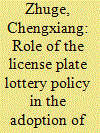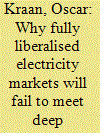| Srl | Item |
| 1 |
ID:
167013


|
|
|
|
|
| Summary/Abstract |
This paper analyses the scale of asset stranding of global natural gas production and transmission infrastructure between 2015 and 2060 using Gas-GAME-Spot, an agent-based gas-sector model. It extends the existing modelling efforts by considering contract constraints in short-term gas sales and explicitly simulating trade in two types of spot markets. The study also contributes to the methodologies of stranded asset analysis by taking into account two aspects which are commonly overlooked: market fluctuation subject to the changing export capacities and the impacts of market signals on investor decision making. The results of the base scenario indicate that if gas demand follows current policy expectations, the scale of asset stranding is likely to be limited. This is attributed to supply capacity shortage of medium-sized exporters due to a slowing of their investment. Moreover, two alternative scenarios show that, when the markets face sudden reduction in demand, they leverage the flexibilities in their long-term contracts and opt more gas through spot trade. Though the issue of stranding is not significant globally in these scenarios, exporting regions with high short-run delivery costs, especially North America and Australia, have higher risks of asset stranding as they are arguably less competitive in spot sales.
|
|
|
|
|
|
|
|
|
|
|
|
|
|
|
|
| 2 |
ID:
176660


|
|
|
|
|
| Summary/Abstract |
Constructing spot markets is the core objective of the new round of electricity market reform kicked off in 2015 in China. A balancing market, as a critical part of a spot market, is an institutional arrangement that deals with balancing electricity demand and supply. Imbalance settlement provides a mechanism for settling the inevitable discrepancies between contractual agreements and physical delivery. Large proportions of long-term non-financially contracted electricity and a high share of renewable generation represent specific market situations in China and make balancing market operation and relevant imbalance settlement more difficult. This paper aims to investigate the effect of imbalance settlement design and exploit an effective evaluation method. An investigation model combining the methods of agent-based modelling (ABM) and multiple criteria decision analysis (MCDA) is proposed to search for the optimal design elements for China's imbalance settlement. Different tolerance margins, Programme Time Units (PTUs) and imbalance pricing mechanisms in imbalance settlement design are analysed. The impacts of imbalance settlement on the behaviour of market participants and overall market are revealed. Finally, corresponding policy implications for imbalance settlement in China's balancing market are put forward. The proposed model also offers a tool for evaluating other design elements in a balancing market.
|
|
|
|
|
|
|
|
|
|
|
|
|
|
|
|
| 3 |
ID:
176653


|
|
|
|
|
| Summary/Abstract |
Policy is an influential factor to the purchase and usage of Electric Vehicles (EVs). This paper is focused on the license plate lottery policy, a typical vehicle purchase restriction in Beijing, China. An agent-based spatial integrated urban model, SelfSim-EV, is employed to investigate how the policy may influence the uptake of EVs over time at the individual level. Two types of “what-if” scenario were set up to explore how the methods to allocate the vehicle purchase permits and the number of permits might influence the EV market expansion from 2016 to 2020. The results suggested that 1) both the allocation methods and the number of purchase permits could heavily influence the uptake of EVs and further its impacts on vehicular emissions, energy consumption and urban infrastructures; 2) compared to the baseline, both scenarios got significantly different spatial distributions of vehicle owners, transport facilities, vehicular emissions and charging demand at the multiple resolutions; 3) SelfSim-EV was found as a useful tool to quantify the nonlinear relationships between the increase of EV purchasers and the demand for transport facilities and electricity, and also to capture some unexpected results coming out from the interactions in the complex dynamic urban system.
|
|
|
|
|
|
|
|
|
|
|
|
|
|
|
|
| 4 |
ID:
166705


|
|
|
|
|
| Summary/Abstract |
Full decarbonisation of the electricity system is one of the key elements to limit global warming. As this transition takes place, the electricity system must maintain system adequacy and remain affordable to consumers. In liberalised electricity markets investors are seen as key actors driving this transition.
|
|
|
|
|
|
|
|
|
|
|
|
|
|
|
|